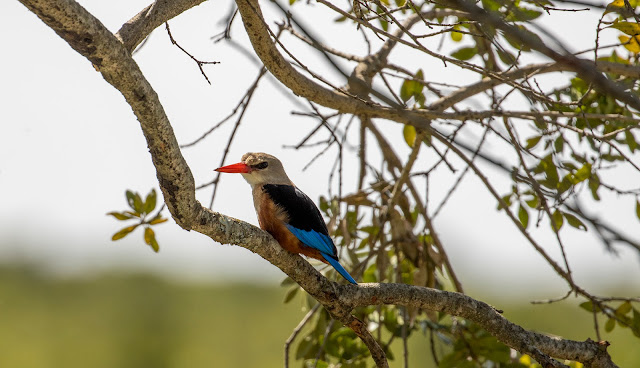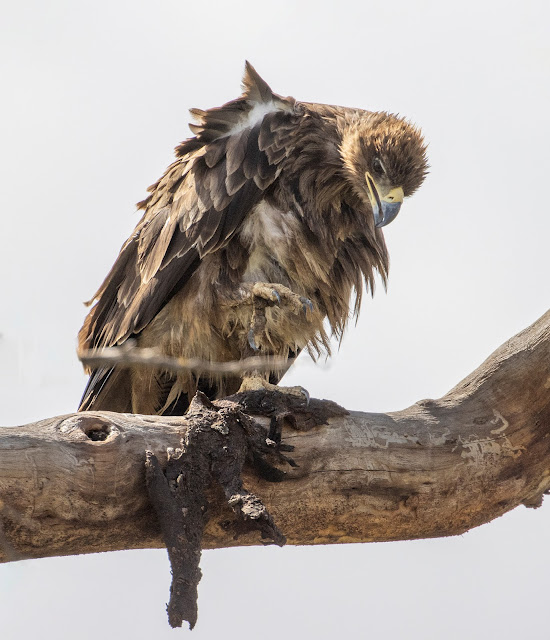Up once again before the crack of dawn and hopefully today will bring some excitement.
Our first sighting was this hyena cub who posed quite well and then proceeded to lick the mud off the truck's tyres.
Next up was this little cutie.
Who then entertained us to this fast moving run around.
A family of defassa waterbuck (Toilet Paper), I know the last image isn't well focussed but I'm including it as it's the first baby I've seen
This tree was just full of Speke's Weavers
I didn't have a clue what this plant was, the seed pod reminded me of a gooseberry but I have since discovered it is Gomphocarpus physocarpus – commonly called Hairy Balls and native to the area.
Peter then suggested we go over to the Eastern side of the conservancy and see what was around. This sign on the bridge over the boundary river made us chuckle.

Look at the length of the horn on the middle Rhino, no wonder it can barely raise its head.
The calves are so cute but their heads look very deformed when they are this age (sorry, rubbish pictures but Peter doesn't like to get too close when the cow has such a young calf and quite rightly).
We then headed towards the Rhino sanctuary which is home to the last 2 remaining Northern White Rhino which, unfortunately for the continuation of the subspecies, are both female and neither of them are able to carry a calf to full term.
There is still a breeding programme in place which aims to implant artificially developed embryos using Southern White Rhino as surrogates.
We were incredibly lucky as they were grazing near the perimeter fence of their huge compound and I found it extremely distressing to be looking at the last two animals of their kind - what have we (man) done! This is Najin
Sudan, the last remaining male, was put to sleep due to age related health issues in 2018
Ol Pejeta is also home to the Sweetwaters Chimpanzee Sanctuary for orphaned and abused chimps but although it is a worthwhile organisation we didn't really fancy visiting as chimps are not native to Kenya and all are animals rescued from bad situations or war torn countries. In pre-Covid times there was an option to go into their compound at feeding time which may have been interesting, but photographing through the wire is not something I enjoy.
On the fence of the Rhino enclosure was this Pin-Tailed Whydah (rear view naturally).
Just a short distance away was the Rhino Cemetery.


One of the armed rangers patrolling on his motorbike - there is zero poaching in the conservancy which is fantastic news.
I can't resist a smug Silver Backed Jackal (even though this one looks like he's only got 3 1/2 legs).
I don't think it's hard to imagine what this once was (Cape Buffalo)
Peter then found us the most beautiful, tranquil spot for breakfast - what an amazing view for our final day's breakfast.
Although it looks like Ian and Peter are practising their disco moves, I think they're pointing to a Nubian Woodpecker high up in the trees on the opposite bank.
Beautiful colouring on this gnarled bark.
We then followed the river along for a little while.
Spoonbill
Grey-Headed Kingfisher
Another LBR - having complained I didn't get any decent opportunities, the little blighters are now everywhere.
At one time the land was owned by Adnan Khashoggi, a billionaire arms-dealer and businessman considered one of the richest men in the world in the early 1980s. In fact Peter’s father worked for him as a game warden and it was through him that Peter’s love of wildlife started. This was Khashioggi's house and rumour has it that the place is being renovated for exclusive rental.
Driving along a fairly wide track we came across this Black Rhino sitting down resting a little way off the track, however Peter didn't risk driving past but took a wide detour on the rough ground so we were well away from the animal.
Their eyesight is notoriously bad (apparently they can't see a motionless person at 30m) and when you look at the size of their eye compared with the rest of them you can appreciate why.
I asked him what happened with self-drivers as I can imagine unfortunately some people have no clue how they should behave around such dangerous animals and he said there had been a few "unfortunate incidents" but they were rare.
We continued for a short while and watched this small herd of elephant just across the river (whether it's the mud they've hurled all over themselves or just the light today, but they all look a bit magenta coloured).
So I've used a bit of artistic licence here.
We gave the rhino the same wide berth when we passed him again.
A few bird sightings as we made our way back towards the Western side.
A very scruffy looking Tawny Eagle
European Bee Eater
Village Weavers and their beautifully constructed nests.
I know - sorry!
Striped Kingfisher
Meyer's or Brown Parrot (actually Peter hadn't heard it described as Meyer's but when he looked it up we were correct) which appears to be devouring its own foot!
However in the next image the foot is clearly intact?
Ruppell's Long Tailed Starling
As we were watching the starlings, Peter noticed a pair of Grey Headed Kingfishers taking it in turns to dive bomb something on the bank and with his sharp eyes spotted a monitor lizard heading straight for the Kingfisher's nest in the bank which probably contained two eggs. This isn't a straight shot as I wasn't quick enough to get them both in the frame, but it's a true representation of what happened and it didn't end well for the eggs!
I am definitely getting better at birds in flight as this shot of a Lesser Kestrel just having taken off shows.
An interesting and varied morning.



















































